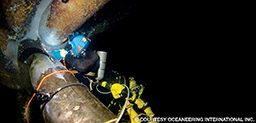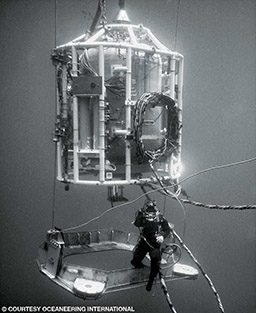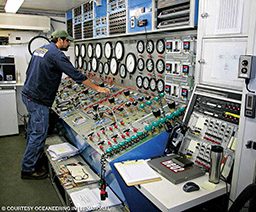When asked about technical divers conducting deep mixed-gas dives, many commercial diving veterans roll their eyes and offer a simple declaration: “They’re crazy!” Their pronouncement should not be dismissed lightly.
Like the U.S. Navy (USN) before them, the offshore commercial diving industry — think construction work underwater — adopted mixed-gas technology in the 1960s to overcome the limitations of deep air diving, as oilfield diving requirements began pushing beyond the 200- to 250-foot depth range. Although it took time to develop needed technology and protocols, the industry — which must adhere to numerous regulations, including those of the U.S. Coast Guard (USCG), the Occupational Safety and Health Administration (OSHA), the Association of Diving Contractors International (ADCI) consensus standards and client standards such as those of the International Association of Oil and Gas Producers (IOGP) — has an exemplary safety record, given the nature of the work.
Based on USCG commercial diving fatality and incident statistics, there has not been a U.S. offshore commercial diving fatality since 2011.1 In fact, if someone dies or suffers a fatality or serious accident on the job, the diving contractor is prohibited from further diving until an investigation is completed and a suitable plan put in place to prevent future fatalities. By contrast, technical divers account for an average of at least 20 fatalities each year worldwide; annual sport diving fatalities total on average roughly five times more.2

Soon tech divers may be the only community other than military rebreather divers conducting deep mixed-gas “bounce” (surface-to-surface) dives. The trend in commercial diving (and USN surface-supplied diving) over the past decade has been to eliminate mixed-gas bounce dives in favor of saturation diving due to its increased safety, efficiency and cost savings. In a “sat dive,” divers live and work under pressure for the duration of the job and are decompressed once upon completion of the job.3
While USCG regulations require that jobs deeper than 300 feet be conducted using saturation diving, many clients such as BP and Shell Global don’t allow mixed-gas surface diving (except with nitrox) and mandate saturation diving below 120 feet of seawater (fsw).4 Today surface-based mixed-gas dives are used only for relatively short inspections or jobs in which remotely operated vehicles (ROVs) would be ineffective, such as opening a valve in a subsea ditch in zero visibility. Contractors rely on saturation diving for longer and/or deeper jobs to a maximum of about 1,000 feet.
To appreciate the commercial perspective, it’s helpful to compare typical commercial mixed-gas dives with those conducted by tech divers. We turned to Oceaneering Inc., which was founded in 1964 and pioneered early mixed-gas diving and safety protocols; they have not had a wet diving fatality since 1977.5 Specifically, we examined a dive to 250 feet for 40 minutes, well within technical diving range, using Oceaneering protocols.

Gear-Intensive Diving
Offshore commercial mixed-gas dives are conducted from a ship or platform and managed topside by the diving supervisor, who is stationed in the onboard dive control office and has a hardwired communications line to the diver. Personnel transport the diver to and from the worksite in a wet bell. In addition to the supervisor and primary diver, regulations require a tender to accompany the diver in the bell, a standby diver and tender, and sometimes an additional “short notice” standby diver and tender. For bailout, divers carry a scuba cylinder, which is plumbed into their helmet, and they wear a wetsuit or hot-water suit. Divers do not use drysuits because of the risk of an uncontrolled ascent.
All gases are surface supplied (open circuit) to the diver by an umbilical that connects through the diving bell to the working diver’s helmet, which is fitted with a demand regulator. Oceaneering uses standardized breathing gases for the working portion of the dive and decompression. Like the USN, they use heliox (a mixture of helium and oxygen) as a bottom gas, either heliox 90/10 (90 percent helium, 10 percent oxygen), heliox 84/16 or heliox 80/20, depending on the depth. The bottom partial pressure of oxygen (PO2) must not exceed 1.5 atmospheres absolute (ATA) and are subject to oxygen exposure limits: no more than 30 minutes at 1.5 ATA, 60 minutes at 1.3 ATA, and so forth. Topside personnel continuously monitor oxygen levels in the diver’s umbilical during the dive, and divers wear on their chest a pneumofathometer that monitors depth. Unlike with saturation dives, helium is not reclaimed on bounce dives, increasing the dives’ relative expense.
Oceaneering uses three gases for decompression: air from 170 feet, nitrox 50/50 (50 percent oxygen, 50 percent nitrogen) from 90 feet, and 100 percent oxygen. The surface crew strictly controls gas switches.
“Underwater gas switching controlled by the diver has seen almost every kind of accident known to man,” Oceaneering’s diving technical manager Jack Couch explained. Peter Buzzacott, DAN’s former director of injury monitoring and prevention, added, “Breathing the wrong gas at depth remains one of the most common ‘preventable’ causes of death in technical diving.”
Oceaneering relies on surface decompression on oxygen (SurD O2), whereby the diver’s oxygen decompression is carried out in a hyperbaric chamber on deck to minimize environmental hazards of in-water time. After completing the stop at 40 feet on nitrox 50/50, the diver ascends to the surface and has three minutes to remove gear and enter the decompression chamber. The diver is pressurized to 50 feet and placed on oxygen for 10 minutes and then ascends to 40 feet, where the diver completes oxygen decompression (PO2=2.2 ATA) with a five-minute air break every 30 minutes.
Mixed bottom times are limited by regulation and to ensure that in-water decompression times are less than 100 minutes to minimize environmental hazards. In the past, decompressing divers have been fatally crushed by equipment, had an umbilical caught in a propeller and been dragged to the surface from 150 feet by a manta ray entangled in the umbilical. Oceaneering permits a maximum of 40 minutes of bottom time at 250 feet, but IOGP clients limit mixed-gas bounce dives to 246 feet (75 meters) of depth and a maximum bottom time of 30 minutes unless a waiver is obtained. Multiple divers can be rotated in and out if more time is needed to complete a job.
| Depth | Oceaneering Mix Dive* – Time (min) | Technical Mix Dive (OC)-Cave** – Time (min) | Technical Mix Dive (OC)- Open Water** – Time (min) |
|---|---|---|---|
| 0 | |||
| 250 | 40 min (Heliox 84/16) | 40 min (Trimix 15/55) | 40 min (Trimix 15/55) |
| 170 | |||
| 160 | 7 min (AIR) | ||
| 150 | |||
| 140 | 1 | 1 | |
| 130 | 6 | 2 | 2 |
| 120 | 3 | 2 min (Trimix 35/25) | 3 |
| 110 | 4 | 2 | 4 |
| 100 | 4 | 3 | 5 |
| 90 | 3 min (Nitrox 50/50) | 3 | 6 |
| 80 | 9 | 4 | 9 |
| 70 | 9 | 4 min (Nitrox 50/50) | 5 min (Nitrox 50/50) |
| 60 | 11 | 6 | 6 |
| 50 | 13 | 8 | 8 |
| 40 | 16 | 10 | 13 |
| 30 | 16 | 19 | |
| 20 | 60 min (O2)*** | 70 min (O2)*** | |
| 10 | |||
| 0 | |||
| Surf Chamber | |||
| 50 | 10 min (O2) | ||
| 40 | 167 min (w/30-min air breaks) | ||
| 0 | |||
| Total Runtime | 291 min | 174 min | 204 min |
| Total Deco | 232 min | 121 min | 151 min |
**Technical dive profiles are calculated using Global Underwater Explorers (GUE) standard gases trimix 15/55 (15% O2, 55% He, bal N2) for bottom gas , trimix 35/25, nitrox 50/50 and 100% O2 for deco. Calculations made using DecoPlanner 3 with ZH-L16 algorithm with Gradient Factors 50/85. Cave dive conducted using 3 deco gases, open water w/ 2 deco gases.
*** The last 6 min would probably be conducted as a slow ascent from 20 ft to the surface.
Note: 250 for 40 min is pushing OC technology. Many tekkies would conduct this dive on CCR.
Table 1 compares the Oceaneering 250-feet profile to two technical open-circuit mixed-gas dives using Global Underwater Explorers (GUE) standard gases for comparison purposes; one dive was conducted in a cave with three decompression gases, the other dive was in open water with two gases. Unlike Oceaneering, technical divers primarily use trimix (an oxygen, helium and nitrogen mix) as bottom gas for open-circuit diving due to the expense of helium, which can cost up to $1.70 to $2.75 per cubic foot, depending on location.

Note that the Oceaneering profile mandates slightly more than 100 minutes of extra oxygen decompression in comparison to the tech dives. It also runs a higher PO2 during decompression (i.e., switching to nitrox 50/50 at 90 ft, PO2=1.86 ATA), as the diver is wearing a helmet, not a mask, and will not drown in the event of a convulsion.
Divers pay some penalty for using SurD O2 in terms of longer decompression time, in exchange for minimizing in-water time, according to Couch. In addition, Oceaneering tables, however, were designed to accommodate the heavy workload performed by commercial divers, often in cold and harsh conditions, resulting in a much longer decompression. “We’re pretty happy with our decompression now,” Couch explained. “We give a pain-only treatment every now and then just to be safe, but most are muscle strains. Outside of patent foramen ovales (PFOs), I’m having difficulty remembering a major decompression sickness incident in the past 10 years or so.”
While commercial mixed-gas diving, which requires significantly more equipment and personnel, is arguably safer than tech diving, surface-supplied divers are simply not able to conduct the types of missions carried out by self-contained tech divers. This is perhaps one of the reasons that makes technical diving so compelling — the chance to experience a realm not previously accessible to humans. Nevertheless, it can be enough to give a commercial diver pause.
“After 41 years in the business where my greatest personal trauma was probably a hang nail,” Couch said, “it’s tough to even think like a tech diver without having the diving safety net found in commercial diving.”
References
- U.S. Coast Guard Marine Information for Safety and Law Enforcement. U.S. Coast Guard and Association of Diving Contractors International Safety Partnership Action Team Meeting Casualty Statistics 2002–2018. Washington, DC: May 29, 2018.
- Buzzacott P, ed. DAN Annual Diving Report 2017 Edition: A report on 2015 diving fatalities, injuries and incidents. Durham, NC: Divers Alert Network, 2017.
- Ferguson S. Saturation Diving. Alert Diver, Summer 2017. Available at: http://www.alertdiver.com/Saturation_Diving.
- Military rebreather divers currently are limited to 300 feet for surface-to-surface diving.
- Oceaneering suffered a single fatality from 1977 to 2018 when an atmospheric diving suit operator was lost as a result of a rigging failure.
© Alert Diver — Q3 Summer 2018